위키 구독하기
Share wiki
Bookmark
SingularityNET
SingularityNET
SingularityNET는 블록체인 기술을 활용하는 분산형 AI 서비스 네트워크입니다. 인공 일반 지능(AGI) 기술 발전에 전념하는 SingularityNET은 AI 접근성을 높이고 영향력, 가치, 기술이 공정하게 공유되는 전 세계 플랫폼 구축에 중점을 두고 있습니다.[1]
개요
싱귤래리티넷(SNET)은 블록체인 기술을 기반으로 하는 분산형 인공지능 서비스 네트워크입니다. 싱귤래리티넷을 통해 개발자는 인공지능 서비스를 게시하고, 인터넷에 연결된 누구든지 이 서비스에 접근할 수 있도록 합니다. 핵심 기능은 자체 AGIX 토큰을 사용하는 것으로, 개발자는 이를 통해 인공지능 서비스 사용료를 설정할 수 있습니다. 싱귤래리티넷이 제공하는 서비스는 이미지 분석, 음성 인식, 텍스트 처리, 생물정보학 등 다양한 분야를 아우릅니다. 서비스는 기본적인 인공지능 알고리즘부터 포괄적인 문제 해결 솔루션, 그리고 네트워크 내에서 원활하게 상호 작용하는 자율적인 인공지능 에이전트까지 다양합니다. [2][3]
싱귤래리티넷은 확장성, 확장 가능성 및 규제 준수를 우선시하는 핵심 아키텍처 설계를 채택했습니다. 특히, 플랫폼은 이더리움 블록체인에 대한 의존성을 줄이고 블록체인과 무관한 원칙을 채택하여 네트워크 상호 작용을 간소화하여 개발자와 사용자 모두에게 사용자 친화적이고 효율적이며 강력한 경험을 제공하는 것을 목표로 합니다. 또한, 싱귤래리티넷은 마켓플레이스와 완전히 분산된 인공지능 서비스 레지스트리를 구분합니다. 이러한 접근 방식은 규제 준수를 보장하면서 개방성과 분산화라는 핵심 원칙을 유지하기 위한 것입니다. [3]
인공 초지능 연합 합병
2024년, 싱귤래리티넷(SingularityNET), Fetch.ai(페치에이아이), 그리고 Ocean Protocol(오션 프로토콜)은 탈중앙화된 인공 일반 지능(AGI) 및 인공 초지능(ASI) 개발을 지원하는 통합 프레임워크를 구축하기 위해 토큰 경제적 합병을 통해 Artificial Superintelligence Alliance (ASI)(인공 초지능 연합(ASI))을 설립했습니다. 이 합병은 싱귤래리티넷의 탈중앙화된 AI 네트워크, Fetch.ai(페치에이아이)의 자율 에이전트 인프라, 그리고 Ocean Protocol(오션 프로토콜)의 탈중앙화된 데이터 교환 기능을 공유 생태계 아래에 통합합니다.
이 계획은 새로운 AI 시스템의 중앙 집중식 제어에 대한 우려를 해결하기 위해 개방적이고 탈중앙화된 대안을 발전시키는 구조를 가지고 있습니다. 이 합병은 협력적인 AGI 및 ASI 연구, 통합 AI 애플리케이션 개발, 그리고 탈중앙화된 컴퓨팅 자원 확장이라는 세 가지 핵심 우선 순위를 중심으로 세 설립 기관의 노력을 조율합니다.
ASI 연합은 전 세계적으로 AI 기술의 윤리적이고 탈중앙화된 발전을 가속화하기 위한 조정된 노력을 나타냅니다. [24]
주요 구성 요소 및 개념
레지스트리
싱귤래리티넷 레지스트리는 이더리움(Ethereum) 블록체인(Blockchain) 상에서 ERC-165 호환 스마트 계약(smart contract)으로 작동하며, 조직, 서비스 및 유형 저장소를 위한 저장소 역할을 합니다. AI 개발자는 레지스트리를 사용하여 자체 AI 서비스에 대한 종합적인 정보를 게시할 수 있으며, 소비자는 필요한 서비스를 식별하는 데 사용할 수 있습니다. 사용자가 마켓플레이스(Marketplace) DApp(decentralized application)에서 검색을 시작하면 레지스트리가 필요한 서비스 정보를 제공하여 사용자가 서비스 및 유형 저장소에 태그를 지정할 수 있도록 하여 검색 및 필터링을 용이하게 합니다. 레지스트리는 플랫폼에서 AI 서비스를 검색하고 사용하기 위한 완전한 정보를 제공하며, 종종 데이터를 전체적으로 나열하거나, 길이가 긴 경우 IPFS(IPFS) 해시를 참조합니다. 레지스트리의 소스, ABI 및 배포에 대한 중요한 정보는 singnet/platform-contracts 저장소에 포함되어 있습니다. [14]
인터페이스
레지스트리 인터페이스인 IRegistry는 레지스트리의 기능을 포괄적으로 설명하는 사양입니다. IRegistry.sol에 위치한 이 인터페이스는 모든 함수에 대해 natspec 호환 문서를 포함하며, 기본적으로 레지스트리가 작동하는 방식에 대한 청사진 역할을 합니다. [14]
데이터 모델
등록서는 조직, 서비스, 유형 저장소 및 태그의 네 가지 주요 데이터 범주를 저장합니다. 이는 이러한 모든 범주에 대해 생성, 읽기, 업데이트 및 삭제(CRUD) 작업을 지원하며 데이터 검색을 위한 여러 보기 기능도 제공합니다. [14]
조직
조직은 서비스를 그룹화할 수 있는 상위 프레임워크를 제공합니다. 각 조직은 레지스트리의 데이터 계층 구조의 정점 역할을 합니다. 서비스 개발자는 조직을 등록하고 그 후 모든 서비스를 해당 조직의 관할 아래에 두도록 권장됩니다. 조직 등록 레코드에는 이름, ID 컨텍스트의 소유자 주소, 구성원 주소 집합 및 서비스 집합이 포함됩니다. [14]
레지스트리 항목에는 이름, 구성원 및 IPFS 해시가 포함되어 있으며, IPFS의 메타데이터 파일에 대한 링크 역할을 합니다. 이 파일에는 지불을 위한 수신자 주소 및 모든 오프체인 채널 상태를 모니터링하는 데 필요한 저장소 세부 정보와 관련된 필수 정보가 포함되어 있습니다. [14]
특정 조직에 등록된 서비스 및 유형 저장소는 해당 조직의 자산으로 간주됩니다. 구성원 목록은 기본적인 액세스 관리 구조 역할을 하며, 구성원은 조직의 보호 아래에서 서비스를 생성, 업데이트 및 삭제할 수 있습니다. [14]
서비스
등록소의 맥락에서 "서비스"는 고유한 AI 알고리즘을 나타냅니다. 등록소에 나열된 각 서비스에는 소비자가 AI 서비스와 상호 작용하는 데 도움이 되는 필수 정보가 포함되어 있습니다. 이 정보에는 서비스를 식별하는 이름, 고객이 서비스를 더 쉽게 찾을 수 있도록 하는 태그, 그리고 IPFS에 저장된 서비스의 메타데이터 파일에 대한 링크 역할을 하는 IPFS 해시가 포함됩니다. 서비스 검색 프로세스를 간소화하기 위해 등록소는 "listServicesForTag"라는 함수를 제공하며, 이 함수는 분산형 애플리케이션(DApp)과 스마트 계약이 특정 태그 또는 범주를 기반으로 관련 서비스를 찾는 데 사용할 수 있습니다. [14]
서비스 메타데이터
서비스 메타데이터는 주로 성능 최적화 및 가스 비용 절감을 위해 IPFS에 오프체인으로 저장됩니다. 이 메타데이터에는 버전 번호, 서비스 이름, 설명과 같은 중요한 정보와 인코딩 및 요청 형식과 같은 서비스 호출을 위한 기술적 통찰력이 포함됩니다. 데몬 엔드포인트 목록도 하나 이상의 그룹으로 집계되어 가격 정보와 함께 포함됩니다. 서비스 API 모델에 대한 IPFS 해시가 제공됩니다. [14]

유형 저장소
레지스트리의 "유형 저장소"는 서비스 개발자가 서비스의 모델 및 해당 서비스가 사용하는 데이터 유형과 관련된 메타데이터를 제공하는 특정 섹션입니다. 이 항목에는 유형 저장소를 식별하는 이름, 사용자가 검색하는 데 도움이 되는 태그, 조직 내의 선택적 내부 관리 경로 및 URI(Uniform Resource Identifier)를 포함한 다양한 세부 정보가 포함되어 있습니다. [14]
URI는 클라이언트가 유형 저장소와 관련된 메타데이터 파일을 찾을 수 있도록 하는 탐색 도구 역할을 합니다. 분산형 애플리케이션(DApp) 및 스마트 계약은 "listTypeRepositoriesForTag" 함수를 사용하여 특정 태그 또는 범주를 기반으로 AI 서비스를 탐색할 수 있습니다. URI는 IPFS 해시로 표시되므로 SingularityNET, 서비스 개발자 또는 Infura와 같은 IPFS 고정 서비스에서 호스팅할 수 있습니다. 이러한 유연성을 통해 다양한 메타데이터 호스팅 옵션을 사용할 수 있습니다. [14]
태그
태그는 AI 서비스와 유형 저장소 모두에 연결된 설명적인 레이블이나 키워드입니다. 이러한 태그는 이러한 리소스를 분류하고 설명하는 방법으로 사용되어 사용자가 자신의 요구 사항이나 관심사에 맞는 특정 서비스나 데이터 유형을 더 쉽게 찾고 식별할 수 있도록 합니다. [14]
용도
- 태그 연결: 싱귤래리티넷(SingularityNET)을 통해 서비스 제공자와 개발자는 레지스트리(Registry)에 있는 AI 서비스 및 유형 저장소에 설명적인 태그 또는 레이블을 연결할 수 있습니다. 이 연결은 "addTagToServiceRegistration"과 같은 특정 레지스트리 메서드를 통해 이루어집니다. 이러한 태그는 리소스에 대한 추가 정보를 제공하고 해당 속성, 도메인 또는 기능을 기반으로 분류하는 역할을 합니다.
- 검색 기능 향상: 서비스 및 저장소에 태그가 연결되면 싱귤래리티넷(SingularityNET) dApp 내에서 눈에 띄게 표시되고 검색 가능해집니다. 즉, 플랫폼 사용자는 관련 태그를 검색하여 이러한 리소스를 쉽게 찾고 검색할 수 있습니다. 예를 들어, 서비스에 "자연어 처리" 및 "의료" 태그가 지정된 경우 의료 관련 자연어 처리 서비스에 관심 있는 사용자는 빠르게 찾을 수 있습니다.
- 역색인: 레지스트리에는 "역색인"이라는 고유한 기능이 포함되어 있습니다. 이 역색인은 레지스트리 계약에 통합되어 중요한 역할을 합니다. 다른 스마트 계약이 연결된 태그를 기반으로 레지스트리에서 서비스 및 저장소를 직접 검색할 수 있도록 합니다. 즉, 외부 애플리케이션, 스마트 계약 및 서비스는 레지스트리에 나열된 서비스 및 데이터 유형에 쉽게 액세스하고 활용하여 "API의 API" 기능이라고 하는 기능의 기반을 형성할 수 있습니다.
다자간 에스크로(MPE)
두 거래 당사자 간의 조건부 거래의 기반을 형성하는 에스크로 계약은 에스크로 계정을 통해 운영됩니다. SingularityNet에서 다자간 에스크로(MPE) 스마트 계약 API와 지불 채널은 AI 소비자와 AI 서비스 제공자 간의 블록체인 상호 작용을 최소화하면서 지불을 용이하게 하기 위해 함께 작동합니다. [15]
MPE 계약은 두 가지 주요 기능을 제공합니다.
- 입금 및 출금 기능이 있는 지갑.
- 단순한 단방향 지불 채널 세트 및 이러한 채널을 관리하기 위한 지원 기능.
결제 채널
두 당사자가 계약을 체결하면 결제 채널을 생성합니다. 결제 채널은 당사자 간의 오프체인 거래를 수행하는 수단으로, 블록체인 블록 생성과 관련된 지연을 제거하고 거래 보안을 유지합니다. [15]
원자적 단방향 결제 채널
다자 에스크로의 핵심 개념은 원자적 단방향 결제 채널입니다. 이러한 채널은 블록체인의 지속적인 업데이트를 방지하기 위해 오프체인으로 유지됩니다. 각 채널은 특정 만료일과 초기 토큰 예치금으로 생성됩니다. 채널 자금 조달을 담당하는 발신자는 서명된 승인을 통해 수신자에게 소액 토큰 전송을 승인합니다. 수신자는 이러한 승인을 검증하여 에스크로된 자금의 정확성과 준수 여부를 확인합니다. 채널의 논스(각 결제 채널과 연결된 카운터 역할을 하는 숫자 값)는 각 청구마다 증가하여 새로운 논스를 사용해야 하는 경우를 제외하고는 채널이 오프라인으로 계속 작동할 수 있도록 합니다. 발신자는 만료일 이후에 남은 모든 자금을 수령하거나 만료일을 연장하고 언제든지 계약에 자금을 추가할 수 있습니다. [15]
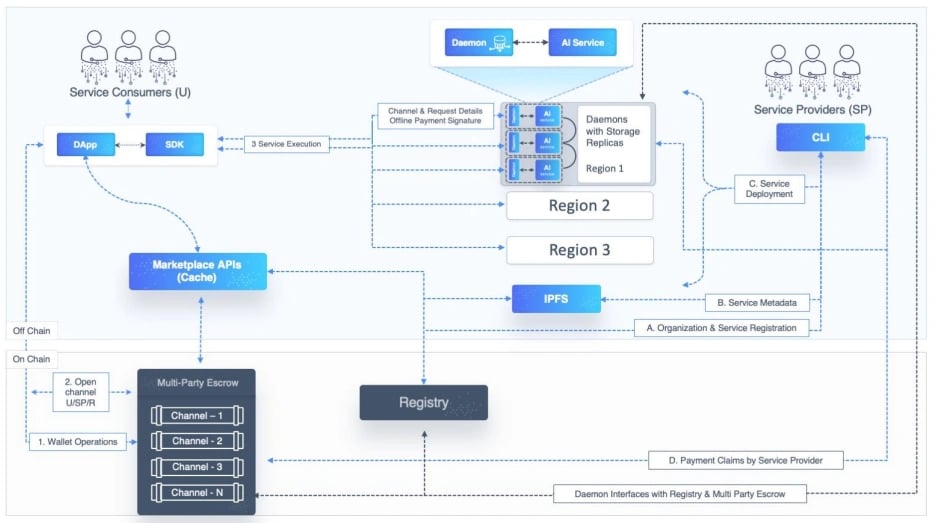
서비스
SingularityNET의 핵심 목적은 다양한 AI 서비스를 위한 분산형 시장을 구축하여 사용자가 이러한 서비스를 직접 사고 팔 수 있도록 하는 것입니다. 이러한 서비스는 광범위한 AI 및 머신러닝 솔루션을 포함하며, 유틸리티 및 어댑터 서비스를 통해 서비스 구성을 간소화할 가능성이 있습니다. "서비스"는 주로 사양과 메타데이터로 정의됩니다. [16]
서비스 사양은 서비스의 API를 정의하는 Protocol Buffer 정의입니다. SingularityNET 클라이언트가 요청 및 응답 구조를 프로그래밍 방식으로 이해할 수 있도록 합니다. 플랫폼에 서비스를 설정할 때 첫 번째 단계는 프로토콜 버퍼를 사용하여 서비스 정의를 만드는 것입니다. [16]
서비스 활용
클라이언트와 데몬은 서비스를 효과적으로 활용하기 위해 두 가지 중요한 정보가 필요합니다. 서비스 메타데이터와 조직 메타데이터입니다. [16]
서비스 메타데이터
서비스 메타데이터는 일반적으로 SingularityNET IPFS 클러스터에 호스팅되는 SingularityNET 서비스의 오프체인 설명입니다. 서비스를 이용하려면 클라이언트에게 다음과 같은 필수 정보가 필요합니다.
- 서비스 메타데이터.
- 멀티파티 에스크로(MPE) 계약의 주소(메타데이터에 포함됨).
- 서비스에 대한 액세스를 제공하는 데몬은 메타데이터를 사용하여 결제 시스템을 구성합니다.
조직 메타데이터
이 부분에서는 SingularityNET 조직 및 서비스에 대한 세부 정보를 제공합니다. SingularityNET 내의 조직 메타데이터는 SingularityNET 조직을 설명하는 정보를 의미합니다. 이 메타데이터는 주로 SingularityNET IPFS 클러스터에 저장됩니다. 조직 메타데이터 파일에는 특정 목적을 가진 다양한 필드가 포함되어 있습니다.
- 유형: 조직이 개인인지 회사인지 여부를 지정합니다.
- 연락처: 조직과 관련된 연락처 정보를 저장합니다. 여러 연락처를 포함할 수 있습니다.
- 연락처 유형: "지원"과 같이 연락처의 성격을 설명합니다.
- 이메일 ID: 연락처와 연결된 이메일을 제공합니다.
- 전화번호: 연락처와 관련된 전화번호를 나열합니다.
- 자산: IPFS에 호스팅되고 메타데이터 내에서 액세스할 수 있는 조직과 연결된 이미지를 참조합니다.
- 그룹: 조직은 여러 그룹과 제휴할 수 있으며, 각 그룹은 특정 결제 유형과 연결됩니다.
- 결제 주소: 결제를 받을 서비스 제공업체의 주소를 식별합니다.
- 결제 채널 저장 유형: ETCD와 같이 결제 관리에 사용되는 저장 유형을 지정합니다.
- 엔드포인트: 클라이언트가 연결을 설정하는 데 사용할 수 있는 저장소 엔드포인트를 지정합니다.
메타데이터 공유
다음과 같은 메타데이터는 세 가지 방법으로 클라이언트와 데몬과 공유할 수 있습니다.
- 단순 JSON 파일: 정보는 간단한 JSON 파일로 제공될 수 있습니다.
- JSON 메타데이터에 대한 IPFS 해시 링크: 클라이언트는 IPFS 해시를 통해 메타데이터에 액세스할 수 있습니다.
- 레지스트리의 서비스 이름: 서비스 이름을 사용하여 메타데이터를 가리키는 해당 IPFS 해시를 찾을 수 있습니다.
데몬
SingularityNET 데몬(snetd)은 AI 서비스와 SingularityNET 플랫폼을 연결하는 데 중요한 역할을 합니다. 주요 작업은 두 가지입니다. 결제 처리와 요청 변환입니다. 결제의 경우, 소비자가 서비스를 사용하기 전에 다자간 에스크로 계약에 자금을 조달하고 활성 결제 채널을 보유하고 있는지 확인합니다. 결제의 진위 여부와 사용 가능한 자금을 확인합니다. 결제가 확인되면 서비스에 요청을 전달하고 다양한 사용자에 대한 결제 상태를 추적합니다. [18]
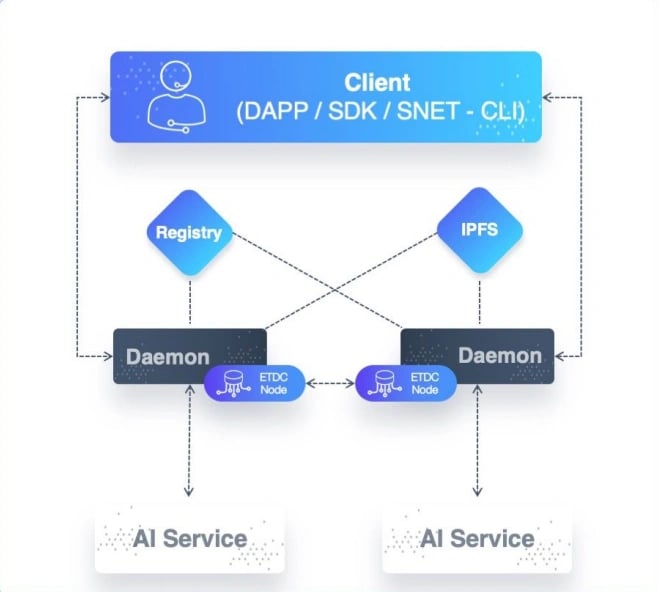
또한, 데몬은 한 가지 형식의 요청을 특정 AI 서비스가 이해하는 형식으로 변환합니다. 이러한 유연성 덕분에 여러 AI 서비스가 자체 snetd를 사용할 수 있으므로 관리 및 조정이 용이해집니다. 데몬은 보안, 모니터링, 속도 제한과 같은 다양한 필수 기능도 제공합니다. SingularityNET 플랫폼 전체는 개방적이고 분산되어 있지만, 마켓플레이스는 현재 베타 단계이며 특정 요구 사항을 충족하도록 관리되고 있다는 점을 명심하십시오. [18]
핵심 기능 외에도 데몬은 SSL 종료, 회전 및 플러그 가능한 로그 후크가 포함된 포괄적인 로깅, 리소스 최적화, 모니터링 및 알림을 위한 메트릭 수집 기능을 제공합니다. 또한 서비스 거부 공격을 방지하고 서비스 소유자가 자체 속도로 확장할 수 있도록 속도 제한 기능도 제공합니다. [18]
호출 유형
- 상태 서비스 호출: 클라이언트는 지불 채널 상태를 고려하여 서비스 호출에 서명할 다음 금액을 확인하기 위해 이 호출을 사용합니다.
- 종량제 호출: 클라이언트는 누적 금액에 가입하고, 데몬은 적절한 검증 및 인증을 보장하며 사용량을 추적합니다.
- 무료 호출: 서비스 제공업체는 제한된 무료 호출을 제공할 수 있으며, 검증 및 사용량 추적은 데몬에서 처리합니다.
- 제어 서비스 호출: 데몬은 서비스 제공업체가 블록체인에 청구를 하기 위해 필요한 데이터를 검색하기 위한 다양한 gRPC 호출을 제공합니다.
- 미청구 요청 목록: 이 기능은 미청구 자금을 식별하여 서비스 제공업체가 미지급금을 인지하도록 합니다.
- 청구 시작 요청: 이 기능을 통해 지불에 대한 청구를 시작하고 관리할 수 있습니다.
- 진행 중 목록: 데몬은 시작되었지만 아직 완료되지 않은 청구에 대한 가시성을 제공합니다.
데몬 API
클라이언트가 게시된 서비스에서 제공하는 메서드를 호출하려면 gRPC 메타데이터를 통해 결제 정보를 전달합니다. 서버는 응답으로 특정 gRPC 오류 코드를 반환하며, 이는 다음 섹션에서 설명합니다. [20]
gRPC 메타데이터
gRPC 메타데이터는 클라이언트가 서비스 요청을 시작할 때 서버에 필수적인 결제 정보를 전송하는 메커니즘으로 사용됩니다. 이 메타데이터를 통해 클라이언트는 결제 프로토콜 유형("escrow" 현재 컨텍스트), 결제 채널 ID, 결제 채널 nonce, 승인된 결제 금액, 클라이언트의 결제 서명을 포함한 주요 정보를 지정할 수 있습니다. 이 데이터는 서버가 요청을 처리하고 안전하고 정확한 결제 실행을 보장하는 데 필요한 결제 컨텍스트를 제공합니다. [20]
제품
AI 마켓플레이스
싱귤래리티넷 마켓플레이스는 탈중앙화 애플리케이션(DApp)으로, AI 서비스의 허브 역할을 합니다. 사용자 친화적인 웹 인터페이스를 제공하여 사용자로부터 복잡성을 추상화함으로써 이러한 서비스와의 상호 작용을 단순화하는 것을 목표로 합니다. 이 마켓플레이스는 MetaMask 또는 General Wallet을 통해 결제를 관리하고 서비스 평점을 처리합니다. 새로운 조직이나 서비스를 게시하는 것과 같은 블록체인 이벤트를 지속적으로 모니터링하여 데이터베이스를 신속하게 업데이트합니다. 싱귤래리티넷 마켓플레이스는 다양한 입법 지역의 법적 요구 사항에 맞춰 플랫폼의 큐레이션된 보기 역할을 합니다. [7]
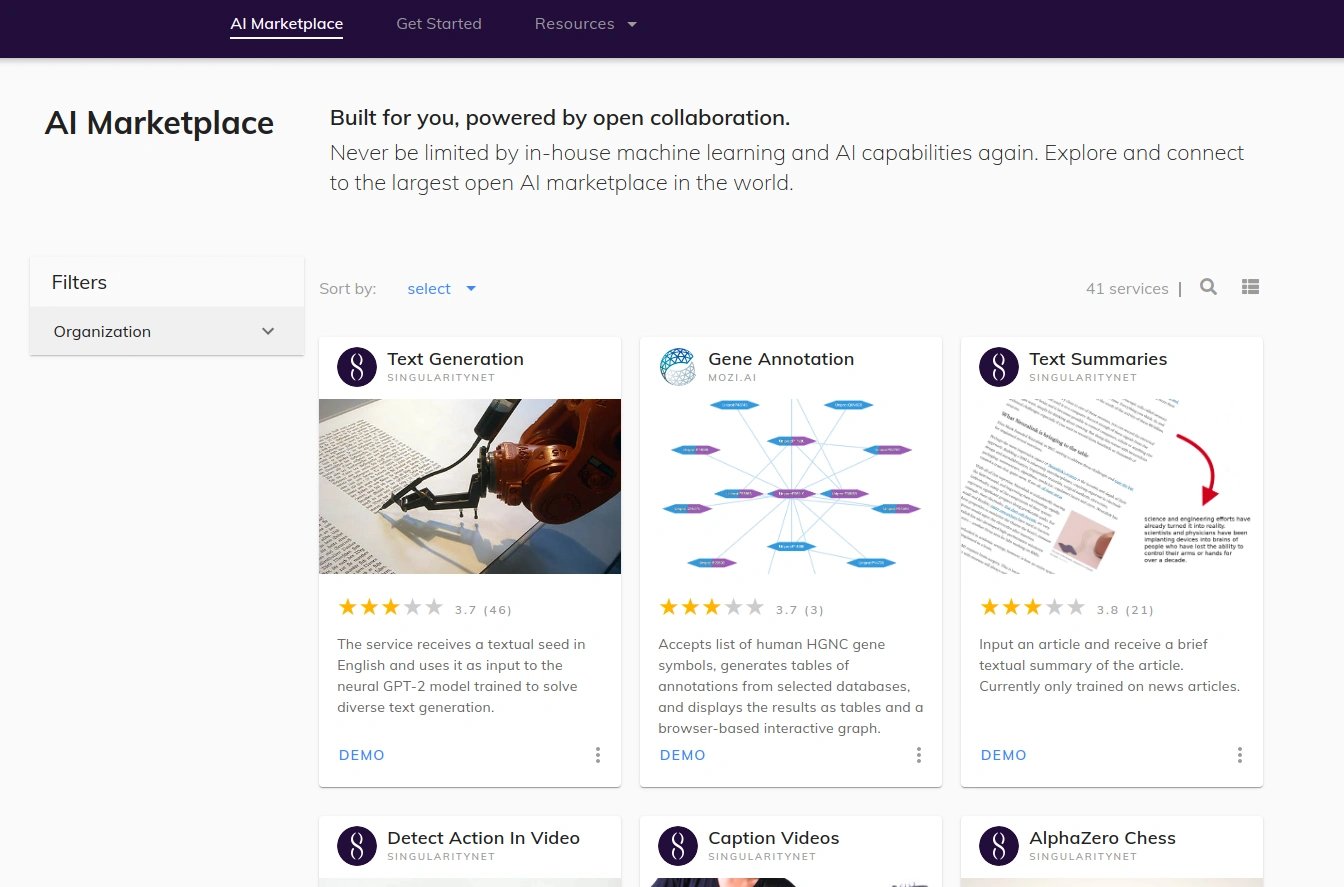
주요 기능
- 데이터 집계: 온체인 레지스트리의 데이터를 수집하고 오프체인 메타데이터와 연결합니다. 이를 통해 AI 서비스를 쉽게 검색, 필터링 및 검색할 수 있습니다.
- 큐레이션: 이 DApp은 SingularityNET 큐레이션 서비스를 통합하여 검증된 서비스와 신뢰할 수 있는 소유자만 표시합니다.
- 사용자 지정 UI 구성 요소: AI 서비스와 상호 작용하기 위한 UI 구성 요소를 제공하여 사용자 경험을 단순화하고 gRPC 프로토콜의 복잡성을 숨깁니다.
- 결제 통합: 마켓플레이스는 원활한 서비스 결제를 위해 다자간 에스크로와 통합되며 서비스 평가 메커니즘도 제공합니다.
- 사용량 측정: 소비자 수준에서 사용량 측정항목을 수집하여 서비스 평가에 도움이 됩니다.[7]
AI 게시자
AI 게시자는 게시자 포털로도 알려져 있으며, 개발자가 조직 및 서비스 게시 및 관리 프로세스를 간소화하기 위한 도구입니다. 주요 목적은 Marketplace DApp에 서비스 목록을 사용자 친화적으로 표시하는 것을 단순화하는 것입니다. [8]
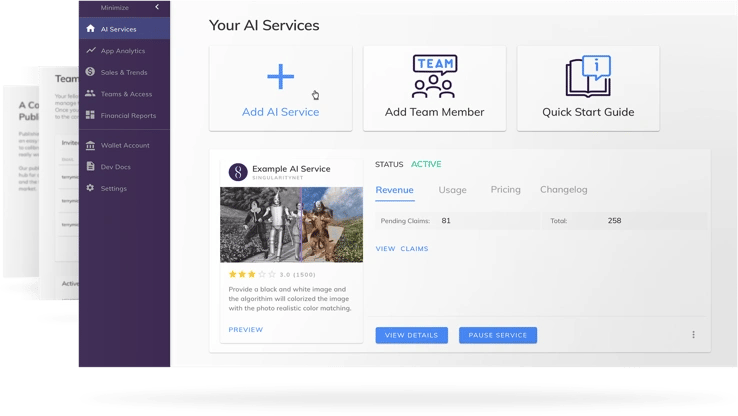
주요 기능
- 조직 온보딩:
- 개발자는 사용자 친화적인 양식을 통해 조직 게시에 필요한 모든 데이터를 입력할 수 있으며, 명령줄 인터페이스가 필요 없습니다.
- 초대 워크플로우 - 조직에 멤버 추가:
- 이 플랫폼은 간편한 워크플로우를 통해 조직에 새로운 멤버를 추가할 수 있도록 지원합니다.
- 소유자는 멤버의 이메일 주소를 간단히 입력하면 됩니다.
- 그러면 시스템이 멤버에게 초대장을 보내고, 초대를 수락하면 지갑 주소를 포함한 모든 필요한 정보가 제공됩니다.
- 블록체인에 조직 게시:
- 조직 세부 정보가 완료되면 자동 검토 프로세스가 시작됩니다.
- SingularityNet 팀이 제출된 정보를 승인하면 포털을 통해 조직을 게시할 수 있습니다.
- 서비스 목록 화면:
- 이 화면에는 해당 조직 내에서 관리되는 모든 서비스의 종합 목록이 표시됩니다.
- 해당 조직과 연계된 멤버만 서비스를 보고, 추가하고, 수정하고, 삭제할 수 있습니다.
- 서비스 메타데이터 화면:
- 명령줄 인터페이스와 비교하여 프로세스를 간소화하기 위해 개발자는 양식을 사용하여 서비스 게시에 필요한 모든 관련 메타데이터를 입력할 수 있습니다.
- 블록체인에 서비스 게시:
- 서비스 세부 정보를 입력한 후 검토 프로세스를 통해 마켓플레이스 DApp에 서비스를 온보딩하기 전에 법적 요구 사항을 준수하는지 확인합니다.
- 게시자 포털을 통한 간편한 청구:
- 게시자 포털은 이제 청구 프로세스를 간소화합니다.[8]
AGIX 토큰
이더리움(Ethereum) 블록체인에서 호스팅되는 AGIX 토큰은 SingularityNET 생태계의 기본 구성 요소 역할을 합니다. 주요 기능은 사용자가 마켓플레이스 내에서 AI 서비스 및 제품에 대한 비용을 지불할 수 있도록 하는 것입니다. 또한, AGIX는 카르다노, 폴리곤, 바이낸스 스마트 체인을 포함한 여러 블록체인과 호환되어 유용성을 높입니다. [4][5]
유틸리티
- 거래: AGIX는 SingularityNET 플랫폼 내 거래에 사용되며, AI 서비스가 모든 사람에게 접근 가능한 글로벌 공유 인프라가 되도록 하는 것을 목표로 합니다. 상호 운용성, 모듈성 및 확장성을 제공하여 AI 에이전트와 사용자 간의 상호 작용을 더욱 효율적으로 만듭니다.
- 결제: AGIX는 다양한 프로토콜의 네이티브 토큰에 대한 접근이 필요한 AI 에이전트의 복잡성을 제거합니다. 단일 공개 감사 원장에서 여러 계약, 기술 및 프로토콜에 걸친 거래를 간소화하여 AI 개발자에게 플러그 앤 플레이 경험을 제공합니다.
- 인센티브: AGIX 토큰은 네트워크에 유틸리티를 기여하는 데 대한 보상으로 배포됩니다. 핵심 구성 요소인 AI 큐레이션 마켓은 AI 에이전트의 검색 프로세스를 최적화하고 토큰 보유자가 스테이커가 되도록 유도하여 네트워크 성장에 기여합니다. 이러한 독특한 메커니즘은 큐레이터에게 AGIX 토큰으로 보상하여 역동적이고 효과적인 AI 생태계를 조성합니다.
- 거버넌스: SingularityNET 네트워크 운영은 새로 생성된 토큰의 일부를 네트워크 인프라 및 관련 도구를 향상시키는 기관에 배분함으로써 민주적으로 자금을 조달합니다. 이러한 커뮤니티 중심 접근 방식은 기술의 이점이 모두에게 공유되고 시스템이 커뮤니티의 이익을 위해 작동하도록 하는 것을 목표로 합니다.[6]
AGIX 스테이킹
AGIX 스테이킹은 AI 마켓플레이스 운영을 지원하고 보상을 받기 위해 AGIX 토큰을 보유하는 프로세스입니다. 이러한 스테이킹 메커니즘은 추가적인 AGIX 토큰 풀을 확보하고 필요할 때 AGIX 토큰을 fiat 통화로 전환하는 것을 용이하게 합니다. [9]
법정화폐-암호화폐 게이트웨이
AGIX 스테이킹은 싱귤래리티넷 플랫폼 생태계에서 법정화폐-암호화폐 게이트웨이를 가능하게 합니다. 이 게이트웨이는 사용자가 AGIX 토큰 대신 법정화폐를 사용하여 AI 서비스 제공업체 및 다른 사용자와 상호 작용할 수 있도록 합니다. 하지만 플랫폼 내 모든 가치 교환은 여전히 AGIX 토큰을 사용하여 실행됩니다. 이러한 이중 기능을 통해 플랫폼은 법정화폐를 제공하면서 싱귤래리티넷의 철학 및 운영에 근본적인 AGIX 토큰의 고유한 경제 논리를 유지할 수 있습니다.
자동 법정화폐-AGIX 변환을 포함하는 법정화폐-암호화폐 게이트웨이의 첫 번째 단계는 이미 구현되어 사용자가 PayPal 지갑으로 AI 서비스를 구매할 수 있습니다. 서비스 제공업체가 얻은 AGIX 토큰을 법정화폐로 자동 변환하는 두 번째 단계는 아직 개발 중입니다. [9]
법정화폐-암호화폐 게이트웨이를 운영하려면 법정화폐와 AGIX 토큰의 지속적인 교환이 필요합니다. 여기에는 필요에 따라 법정화폐로 교환할 수 있는 AGIX 토큰의 유동성 풀을 유지하는 것이 포함됩니다. 스테이킹은 이 풀의 가용성을 보장합니다. AGIX 토큰 보유자가 토큰을 스테이킹하면 특정 기간 동안 토큰을 잠그는 데 동의하는 것입니다. 이 기간 동안 이러한 토큰은 재단에 일시적으로 위탁되며, 재단은 스테이킹 프로세스를 관리합니다. 그 대가로 스테이커는 법정화폐 예금에 대한 이자를 얻는 것과 유사하게 보너스 AGIX 토큰을 받습니다. [9]
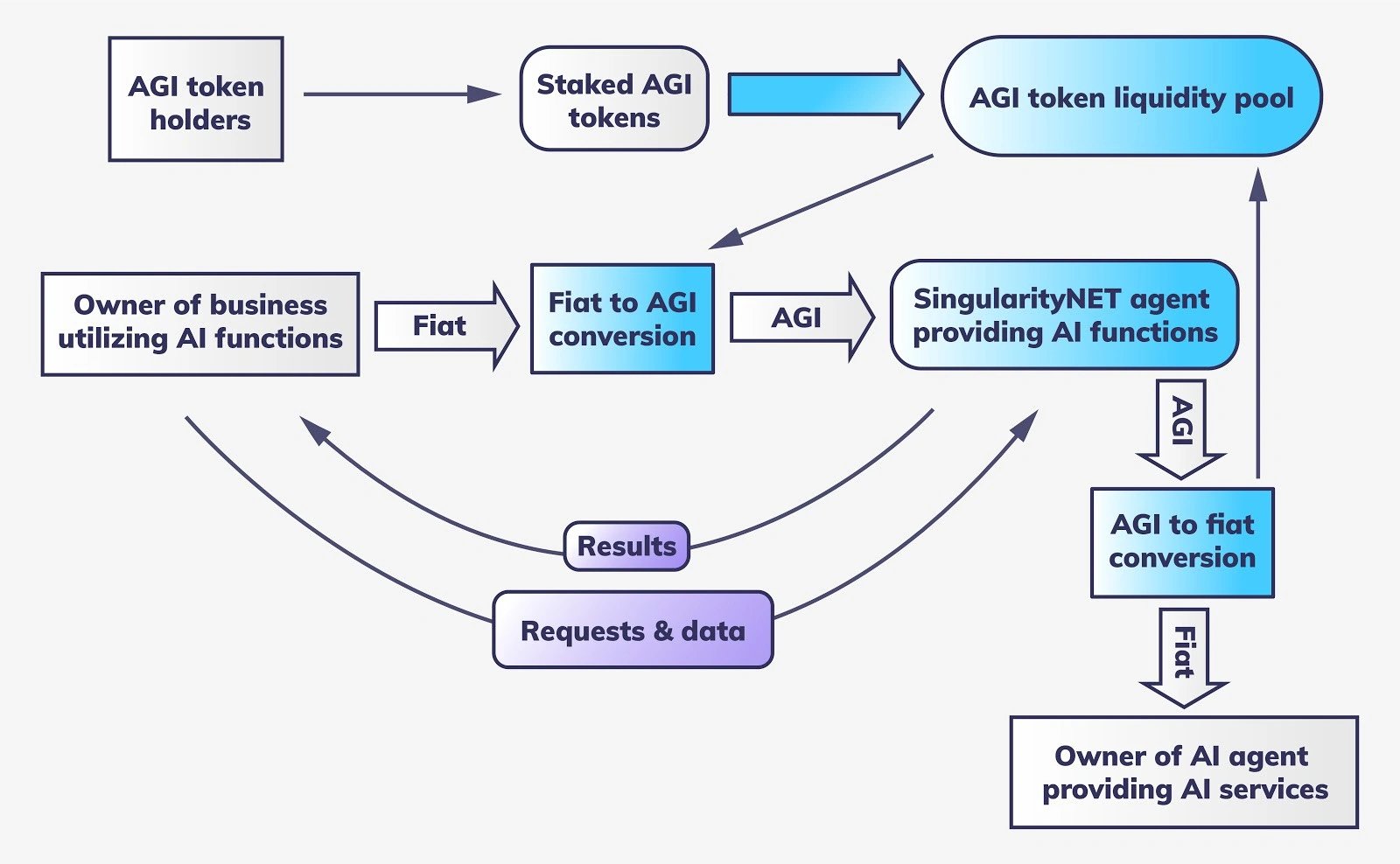
스테이킹 일정
단일 스테이킹 세션은 다음 단계를 따릅니다.
- 스테이킹 기간: 토큰이 스테이킹 스마트 계약에 잠기는 기간입니다.
- 스테이킹 기간: 이 단계에서 AGIX 토큰이 스테이킹됩니다.
- 참여 취소 기간: 사용자는 다음 스테이킹 기간에 참여하지 않도록 선택할 수 있습니다.
- 인출 기간: 스테이킹 기간이 끝난 후 토큰을 인출할 수 있습니다.
스테이크 창
AGIX 토큰 스테이킹은 고정된 시간 창에서 발생하며, 각 창에 앞서 특정 스테이킹 기간 요청이 있습니다. 스테이킹 기간 요청 중에 토큰 보유자는 AGIX 스테이킹 DApp을 통해 스테이킹을 요청할 수 있습니다. 운영의 실현 가능성을 보장하기 위해 최소 AGIX 금액이 필요합니다. 현재 사용자당 허용되는 최대 금액이나 스테이킹에 허용되는 금액 상한선은 없습니다. 그러나 필요하다고 판단될 경우 향후 상한선이 적용될 수 있습니다. [11]
스테이킹 참여 거부
스테이커는 거부 기간 동안 다음 스테이킹 기간에 참여하지 않도록 선택할 수 있습니다. 사용자는 이 기간 동안 원래 결정을 변경하도록 선택할 수 있습니다. 이 기능은 사용자에게 스테이크 금액과 보상을 다음 스테이킹 기간으로 이월할지 아니면 인출할지 결정할 수 있는 유연성을 제공합니다. [12]
스테이크 보상
토큰을 스테이킹하는 대가로 사용자는 예금자의 이자와 유사하게 보너스 AGIX 토큰을 받습니다. 사용자는 참여하는 각 스테이크에 대해 보상을 받으며, 다음 라운드에 참여하지 않기로 선택한 경우 스테이크 기간이 끝나면 이러한 보상이 이체됩니다. AGIX 스테이킹 DApp은 잠재적 보상을 결정하는 사용자 친화적인 계산기를 제공합니다. 스테이킹에 대한 추가 보상이 향후 도입될 수 있으며, 이를 통해 스테이킹은 토큰 보유자가 토큰으로부터 단기적인 가치를 얻을 수 있는 귀중한 메커니즘이 됩니다. [13]
토큰 합병
2024년 6월 3일, SingularityNET은 인공 초지능 연합(ASI) 토큰과 AGIX 토큰의 최종 합병 날짜를 공식 발표했습니다. 이는 fetch.ai (FET), AGIX, 그리고 Ocean Protocol (OCEAN) 커뮤니티를 통합하기 위한 단계였습니다. [22]
2024년 6월 11일부로 FET는 ASI로 이름이 변경되었고, 6월 13일 토큰 합병이 완료되었습니다. ASI 토큰은 통합된 분산형 AI 네트워크에서 작동하며 전례 없는 규모와 성능을 제공합니다. - 팀 발표[23]
FET, AGIX, 그리고 OCEAN 토큰 보유자의 경우, 특정 환산율로 해당 토큰을 ASI 토큰으로 전환하는 합병 절차가 진행되었습니다. [22][23]
팀
창립 팀
- 벤 고르첼 박사 (Ben Goertzel): CEO 겸 최고 과학자
- 데이비드 한슨 박사 (Dr. David Hanson): 공동 창립자
경영진
- 벤 고어첼 박사 (Dr. Ben Goertzel): CEO 겸 최고 과학 책임자
- 재닛 아담스 (Janet Adams): 최고 운영 책임자
- 마리오 카시라기 (Mario Casiraghi): 암호화폐 운영 책임자
- 맷 이클 박사 (Dr. Matt Ikle): 최고 과학 책임자
- 얀 호를링스 (Jan Horlings): 최고 제품 책임자
- 세르게이 샬리아핀 (Sergey Shalyapin): 최고 기술 책임자
- 알렉세이 포타포프 박사 (Dr. Alexey Potapov): 최고 AGI 책임자
- 미하엘라 울리에루 박사 (Dr. Mihaela Ulieru): 최고 AI 알케미스트
- 알렉스 블라기레프 (Alex Blagirev): 전략 이니셔티브 책임자
- 로익 클라보 (Loic Claveau): 최고 마케팅 책임자
이사회
- 벤 고어첼(Ben Goertzel) 박사: CEO 겸 최고 과학자
- 카시오 페나친(Cassio Pennachin): 이사
- 데이비드 레이크(David Lake): 이사
- 우고 디 레바(Ugo Di Leva): 이사
감독 위원회
- David Orban (데이비드 오르반): 관리 고문
- Penny Wong (페니 웡)
잘못된 내용이 있나요?
